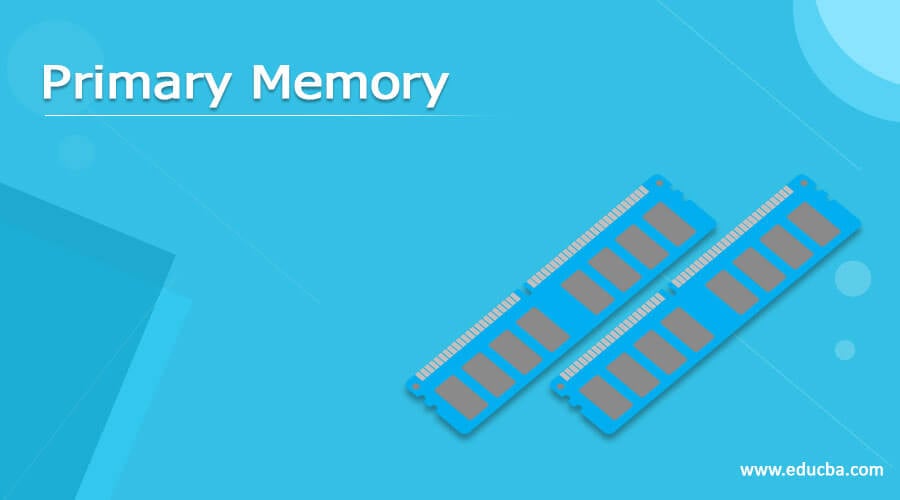Updated April 7, 2023

Introduction to Primary Memory
In order to store data and commands, computers need memory. Memory is mechanically arranged as a vast number of cells, each of which can store one bit of information. They are logically arranged as words, which are groups of bits that are given an address. These memory addresses are used to access data and instructions. The cost is determined by the speed at which these memory addresses can be accessed. The cost of memory is determined by the speed at which these memory addresses can be accessed. The higher the memory level, the more expensive it is.
Memory in computers is arranged in a hierarchical manner, with the fastest access speeds and highest costs at the top, and the slowest access speeds and therefore lowest costs at the bottom.
Primary memory is called main memory as well as “internal memory.” It may also known as primary storage. Primary memory refers to all kinds of computing memories that are directly accessible by the processor via the data bus. This helps a processor to enter memory locations where running programs and currently processing data are stored.
Since primary memory is expensive, technologies are being designed to make it more effective. There are different forms of primary memory that are available.
As a result, all applications that use a microprocessor, like machines, would use memories. RAM and ROM, which store programs, are examples of primary memory. The ability of these memories is small, and they are made with integrated circuits (ICs) or semiconductor devices. It has a higher data access speed than secondary memory. It has a higher price tag than secondary memory.
RAM (Random Access Memory)
Random Access Memory (RAM) is a type of memory that is used to store data. Since the processor explicitly accesses all memory addresses, regardless of word length, storage and retrieval are fast. RAM is the fastest and most expensive memory available. Because of these two variables, RAM is only available in limited amounts of up to 1GB. While RAM is unpredictable, it may be one of these two forms.
DRAM is a type of memory that is used (Dynamic RAM)
In a DRAM, each memory cell consists of one transistor and one capacitor, each of which stores one bit of data. However, when this cell loses its charge, the data stored is lost in less than a thousandth of a second. As a result, it must be refreshed thousands of times per second, which consumes processor resources. However, since each cell is small, a single DRAM may have a huge number of cells.
SRAM is a company that makes semiconductors (SRAM)
SRAM is composed of flip-flops that store one bit in each cell. It doesn’t need to be renewed like DRAM because it keeps its bit until the power supply is turned on. In comparison to DRAM, it also has shorter read-write times. SRAM is a type of memory that is used in specialized applications.
ROM
Read-Only Memory is referred to as ROM. The processor is the only one that can read ROM, as the name implies. It is not possible to write new data into the ROM. Data for ROM storage is written during the production process. They store data that does not need to be changed, such as a computer’s booting sequence or algorithmic tables for mathematical applications. Since ROM is slower than RAM, it is less expensive.
It is non-volatile, meaning it preserves the data even though the power is turned off. While ROMs cannot be modified in the same way as RAM can, technologies exist to program these types of ROMs.
PROM (Programmable ROM)
A PROM programmer or PROM burner is a special hardware unit that can be used to program PROM.
EPROM (Erasable Programmable ROM)
EPROMs may be erased and then programmed with the aid of special electrical signals or ultraviolet rays. UVEPROMs are EPROMs that can be erased with UV rays, while EEPROMs are EPROMs that can be erased with electrical signals. Electric impulses, on the other hand, are simpler to handle and safer than UV rays.
Cache Memory
Cache memory is a small piece of high-speed volatile memory accessible to the processor for fast processing. A cache may be a section of main memory that has been set aside, another chip on the CPU, or a separate high-speed storage unit. SRAMs are used to make cache memory. Caching is the method of storing certain data and instructions in cache memory for quicker access.
When the processor needs data or instructions, it first looks in the cache. If it’s not accessible there, the primary memory is accessed first, followed by secondary memory. Since caches are extremely fast, the time spent accessing them and time is insignificant as opposed to the time saved if data is still in the cache. A cache hit occurs when data or instructions are found in the cache.
Conclusion
In this article, we have seen what is Primary memory, its types, and subtypes. We hope you will find this article helpful.
Recommended Articles
This is a guide to Primary Memory. Here we discuss Introduction, What is Primary Memory and its Types?. You may also have a look at the following articles to learn more –

